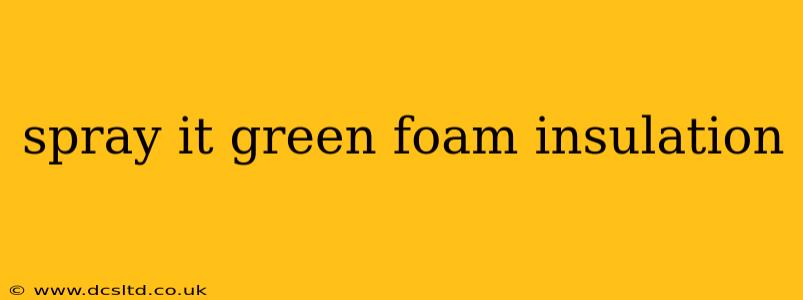Spray foam insulation has become increasingly popular for its superior energy efficiency and air sealing capabilities. But with the growing awareness of environmental concerns, many homeowners are asking: Is spray foam insulation truly "green?" The answer is nuanced, and this guide will explore the eco-friendly aspects of spray foam, its potential drawbacks, and how to make informed choices for a sustainable home.
What is Spray Foam Insulation?
Spray polyurethane foam (SPF) insulation is a two-part liquid mixture that expands dramatically upon application, creating a dense, seamless layer that fills cavities and cracks. This airtight seal significantly reduces air infiltration, leading to considerable energy savings. There are two main types: open-cell and closed-cell. Open-cell foam is less dense, more permeable to air, and generally less expensive. Closed-cell foam is denser, more rigid, provides a better vapor barrier, and offers superior thermal resistance.
Is Spray Foam Insulation Truly Eco-Friendly? "Spray It Green" – Fact or Fiction?
The "greenness" of spray foam insulation depends heavily on its composition and application. Some formulations contain blowing agents with high global warming potential (GWP), like hydrofluorocarbons (HFCs). However, advancements in the industry have led to the development of foams using more environmentally friendly blowing agents, such as hydrofluoroolefins (HFOs), which have significantly lower GWP. Choosing a foam with an HFO blowing agent is a crucial step toward making a more sustainable choice. Look for certifications and labels that verify the use of low-GWP blowing agents.
What are the Environmental Concerns Surrounding Spray Foam Insulation?
While HFO-blown spray foam represents a significant improvement, some environmental concerns remain:
- Manufacturing emissions: The manufacturing process itself contributes to greenhouse gas emissions.
- Potential for off-gassing: Some spray foams can release volatile organic compounds (VOCs) after application, although low-VOC or zero-VOC options are increasingly available. Proper ventilation during and after installation is crucial.
- Disposal: Improper disposal of spray foam can create environmental problems. Always follow the manufacturer's guidelines for disposal.
- Isocyanate exposure: Isocyanates are used in the manufacturing of spray foam and can cause respiratory issues if not handled properly. Professional installation is essential to minimize exposure risks.
What are the Benefits of Eco-Friendly Spray Foam Insulation?
Despite the potential drawbacks, eco-friendly spray foam insulation offers many advantages:
- Reduced energy consumption: Superior insulation leads to lower heating and cooling costs, reducing your carbon footprint.
- Improved air quality: A tight building envelope minimizes air infiltration, preventing allergens and pollutants from entering.
- Increased home comfort: Even temperatures and reduced drafts contribute to greater comfort.
- Enhanced durability: Spray foam insulation lasts for decades, avoiding the need for frequent replacements.
What are the Different Types of Eco-Friendly Spray Foam Insulation?
The "greenness" of spray foam isn't just about the blowing agent. Consider the overall composition. Look for products with recycled content or those made from rapidly renewable resources. Some manufacturers offer certifications and labels indicating the environmental performance of their products. Always inquire about the specific formulation being used.
How Can I Choose an Eco-Friendly Spray Foam Installer?
Selecting a reputable and experienced installer is vital. Look for installers certified by recognized organizations that adhere to strict environmental standards. Ask about their experience with low-GWP blowing agents and their commitment to proper handling and disposal procedures. Request references and check reviews before making a decision.
How Much Does Eco-Friendly Spray Foam Insulation Cost?
The cost of eco-friendly spray foam insulation can vary depending on factors like the type of foam, the size of the area to be insulated, and the installer's fees. While it might be slightly more expensive upfront than some other insulation options, the long-term energy savings can often offset the higher initial investment.
Is Spray Foam Insulation Right for My Home?
Whether spray foam insulation is the right choice for your home depends on your specific circumstances, climate, and budget. Consider factors such as your existing insulation, the age and construction of your home, and your priorities regarding energy efficiency and environmental impact. Consulting with an energy auditor or qualified contractor can help you make an informed decision.
This guide provides a comprehensive overview of eco-friendly spray foam insulation. Remember to always prioritize responsible sourcing and professional installation for optimal environmental benefits and long-term performance. Choosing "green" spray foam requires careful consideration and research, but the potential for reduced energy consumption and a smaller carbon footprint makes it a worthy investment for many homeowners.
